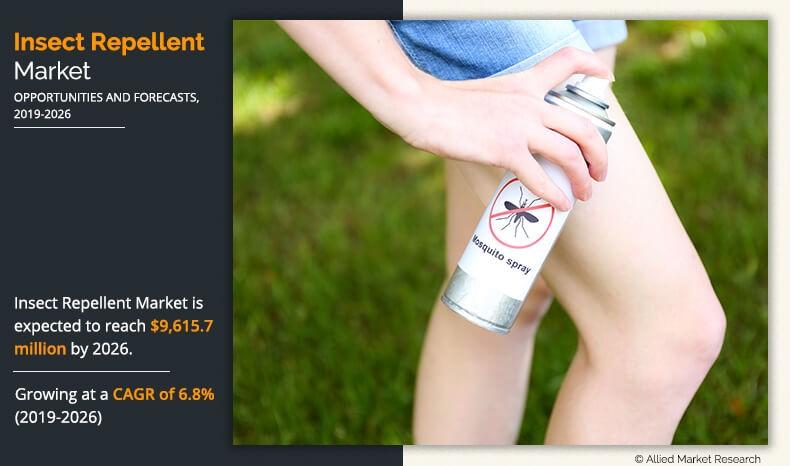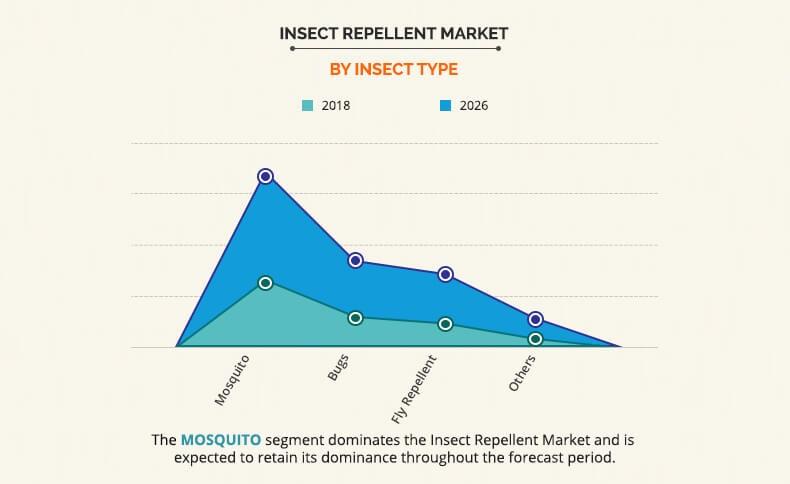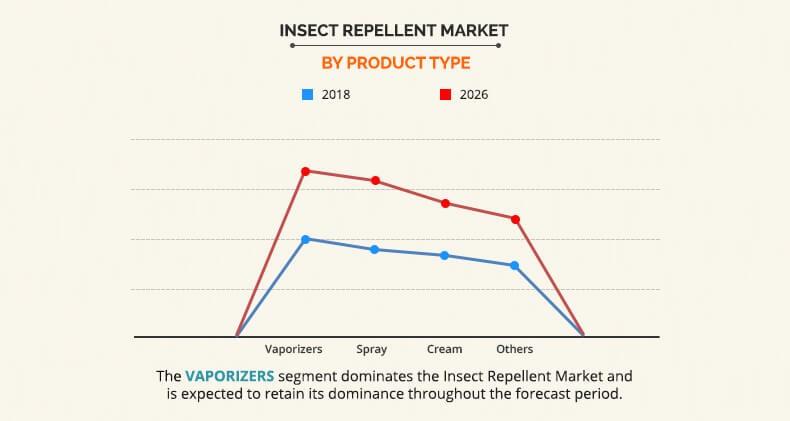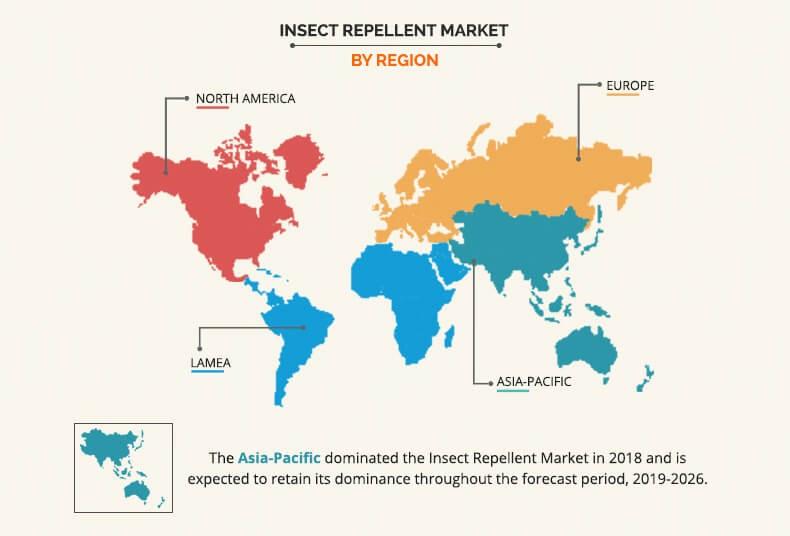Insect Repellent Market Outlook - 2026
The global insect repellent market is expected to generate $ 9,615.7 million by 2026, growing at a CAGR of 6.8% from 2019 to 2026. Insect repellent is a chemical substance applied to skin, clothing, or other surfaces, which discourages insects from landing or climbing on that surface. Insect repellents help prevent and control the outbreak of insect-borne diseases such as malaria, zika, Lyme disease, dengue, bubonic plague, river blindness, and west Nile fever. As consumers have become extremely health conscious these days, the insect repellent market demand has witnessed a significant growth.
Rising consumer awareness regarding insect borne diseases due to increasing waste from commercials facilities or households is anticipated to propel the insect repellent market share growth during the forecast period. Furthermore, rising insect borne diseases due to increasing number of mosquitoes has positively impacted the insect repellent market growth. Regions such as North America, Asia Pacific, and Europe have witnessed a large number of cases of dengue, malaria, and chikungunya. For instance, according to a survey, the number of cases has increased to 2 million in 2017 from 2016 across the countries. Increasing global warming has also led to a rise in the insect borne diseases due to increase in the number of insects. This, in turn, increases the demand for repellents. Government initiatives to control the effects of insects in the surroundings is also likely to impact the growth during the forecast period. For instance, government has come up with integrated pest management that aims at keeping pests under economic level. Increase in the global waste is also impacting the growth of insect repellent market, as it leads to increase in the number of insect borne diseases. For instance, according to the WHO, the global waste is anticipated to grow by 70.0% by 2050. Rise in awareness regarding the benefits of insect repellents, particularly in rural areas, is expected to drive the insect repellent market. In addition, development of commercial repellent products containing plant-based ingredients have gained increasing popularity among consumers, as these are commonly perceived as “safe” in comparison to synthetic repellents.
For instance, Godrej has come up with natural mosquito repellent fabric roll on, which is good for children. Although, some products such as sprays have adverse effects on health due to high content of DEET in them. Products such as repellent liquids also have some negative effects on health. According to a study conducted by the U.S. national library of medicine, people reported different health problems such as breathing problem, itching in eyes, and headache after using insect repellents. Manufacturers are coming up with various products that have less harmful effects on human. This, in turn, is anticipated to boost the insect repellent market size significantly during the forecast period.
The global insect repellent market is segmented on the basis of insect type, product type, and region. By insect type, it is divided into mosquito, bugs, fly repellent, and others. On the basis of product type, it is categorized into vaporizers, spray, cream, and others. By region, the insect repellent market is analyzed across North America (the U.S., Canada, and Mexico), Europe (the UK, Italy, Germany, France, and rest of Europe), Asia-Pacific (China, Japan, India, Australia, South Korea, and rest of Asia-Pacific), and LAMEA (Brazil, Saudi Arabia , South Africa, and rest of LAMEA).
By insect type, it is divided into mosquito, bugs, fly repellent, and others. In 2018, mosquito was the leading segment owing to rise in incidence of mosquito-borne diseases and global warming, which facilitates breeding of mosquitoes. Other factors that drive the market are rising health awareness, government initiatives for mosquito control, and affordable cost of repellents. However, presence of toxic chemicals, such as DEET, in various mosquito repellent products causes ill effects on health, which is likely to restrain the growth of this market. Huge opportunities prevail for the global mosquito repellent market owing to the rise in demand for plant-based repellents and increasing penetration in untapped markets of rural regions.
On the basis of product type, it is segmented into vaporizers, spray, cream, and others. In 2018, vaporizers was the leading segment and is expected to retain its dominance throughout the insect repellent market forecast period. Vaporizer helps in reducing insect count and generally contain herbal. Wide range applications of the product has made it popular among consumers.
By region, Asia-Pacific was the largest insect repellent market share in 2018, owing to the rise in awareness regarding the benefits of insect repellents among consumers and increase in number of insect borne diseases in countries such as India, the Philippines, and Indonesia. In addition, government initiatives in countries such as India regarding awareness of insect borne diseases has further driven the market growth.
The top market players in the global insect repellent industry include Reckitt Benckiser Group, The Godrej Company, Dabur International, Johnson and Johnson, Spectrum Brands, Jyothi Labs, Swayer Ltd., Himalaya Herbals, Enesis Group, and Quantum Health.
Key Benefits for Insect Repellent Market:
- This report provides a quantitative insect repellent market analysis of the current insect repellent market trends, estimations, and dynamics of the global insect repellent market size from 2019 to 2026 to identify the prevailing market opportunities.
- The key countries in all the major regions are mapped on the basis of their market shares.
- Porter’s five forces analysis highlights the potency of buyers and suppliers to enable stakeholders to make profit-oriented business decisions and strengthen their supplier buyer network.
- A comprehensive analysis of factors that drive and restrict the growth of the market is provided in the report.
- An in-depth analysis of the global market helps determine the prevailing market opportunities.
- The report includes details of the analysis of the regional and global markets, key players, market insect repellent market segments, application areas, and growth strategies.
Insect Repellent Market Report Highlights
| Aspects | Details |
| By INSECT TYPE |
|
| By Product Type |
|
| By Region |
|
| Key Market Players | S. C. Johnson & Son, Inc., Dabur International Ltd., Jyothy Laboratories Ltd. (JLL), Johnson & Johnson Services, Inc. (J&J), Coghlan's Ltd., Godrej Consumer Products Limited, Himalaya Herbals, Sawyer Products, Inc., Spectrum Brands Holdings, Inc., Reckitt Benckiser Group plc. |
Analyst Review
Asia-Pacific holds the largest share in the global insect repellent market owing to higher demand for insect repellent products in countries such as China and India. However, the market is at a nascent stage in the rural areas due to lower level of health and hygiene consciousness. Recently, countries in North America, South America, and Africa have witnessed a surge in the demand for mosquito repellent products due to the outbreak of Zika virus caused by Aedes mosquito. Increasing demand for herbal and organic ingredient-based products is offering lucrative business opportunity for the players operating in the market.
The developing markets are characterized by higher adoption of lower priced mosquito repellents such as coils and mats. Penetration level of mosquito repellent sprays, creams, and oils prepared from organic and herbal ingredients is higher in developed markets such as North America and Europe. Moreover, the demand for such high-end products is consistently increasing in developing markets owing to factors such as rising literacy levels and increasing awareness campaigns run by government and players operating in the industry. The industry has witnessed entry of numerous small players since recent past, who manufacture and market innovative insect repellents such as wrist bands, patches, and others.
Loading Table Of Content...







